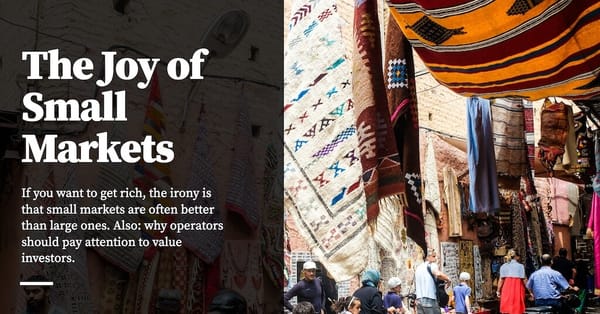If you want to get rich, the irony is that small markets are often better than large ones.
Sometimes I am asked “why are you still in Singapore?” The question behind the question is: “Cedric, I want to aim for a billion dollar outcome. I cannot imagine being a founder if the upside is not at least a billion dollars. Why are you still in Singapore, where the upside is so small?”
Embedded in this question is a model of the world that goes something like this: “only businesses in billion dollar markets are worth doing.” This is the view that is predominant today, because venture capital is the most prominent form of new venture formation, and venture capital demands large outcomes.
But let’s walk through an example that should break this model. This example comes from some smart thinking by Jonathan Knee, a former investment banker turned academic at Columbia Business School. I suspect the example that Knee uses was originally elucidated by Columbia business professor Bruce Greenwald in Competition Demystified, though I disliked the book so much that I learnt about it only by way of investor George Ho (who is aligned with the school; he taught a semester of the legendary Securities Analysis class there).
But this model is also the model that I’ve seen with my own eyes. I’ve mentioned before how the company that I helped build got acquired by Ant Group a few months ago. This was the model of return that I saw at play in my old company; it is the predominant model in the world that I come from, and the way most of the successful SME entrepreneurs I know made their wealth.
And it tells us something interesting: it can be easier to get generationally rich in a small market compared to a large one.
Let’s pretend that you are in a small market — $100M at most. You are one of three major competitors in this market: you each own a third of the market, which means your company makes roughly $33 million a year. Your business is healthy enough that you are able to take out $5 million a year by way of dividends without affecting the health of your business. (If you own 100% of your company, that means $5 million goes straight into your pocket at the end of each fiscal year — this is what Warren Buffett refers to when he says ‘owner earnings’). By an interesting quirk of ‘relative scale’, your share of the market is mostly stable on a year-to-year basis against your two major competitors. Perhaps you gain (or lose) 1-3% of market share a year, only to win it back (or lose it back) the next year. This is about as stable as market structures go. It also implies that no small competitors emerge from below to threaten you, but also no large competitors enter from above.
Why?
This why is the important question to ask. It turns out that ‘relative scale’ is the key unlock to this puzzle. At this point you should be familiar with ‘scale economies’ — the idea that fixed costs can be amortised over a larger customer base, meaning that per-unit costs are lower for the scale player as compared to its sub-scale competitors. But there is also the idea of relative scale economies — that is: what matters is not the absolute size of the company, but the relative size of the market leader in a contained market.
Let us say that you are one of three relative scale players in your market. Small competitors are unable to threaten you because you are in a position of relative scale compared to them: you have a fixed cost base that is amortised across a much larger set of customers, in a way that smaller entrants cannot copy. So your relative size gives you protection from below.
But why don’t large companies enter your market from above? This answer can be idiosyncratic (that is, specific to the particular market we’re talking about), but in general the way to think about this is that large companies see a market that is too small and too expensive to pursue. Let’s say that it will take a large company five years and $25 million dollars a year to win a quarter of your market. That means spending $125 million dollars in total (and five years of fierce execution!) to win 1/4 of a $100 million dollar market, shared with three other major competitors. This cost is not typically worth the prize — unless capital is exceedingly cheap, or there is a non-economic reason present … or the large business has run out of other lucrative opportunities to pursue. But the more likely outcome is that folks in this large company will conclude that attacking your sleepy market is not worth it. And so larger companies will mostly ignore you, or at most they enter for a number of years and then give up.
This mental model around ‘relative scale’ explains a great number of quirks that we might observe in the SME space.
Originally published , last updated .
This article is part of the Market topic cluster, which belongs to the Business Expertise Triad. Read more from this topic here→
This article is part of the Capital topic cluster, which belongs to the Business Expertise Triad. Read more from this topic here→





